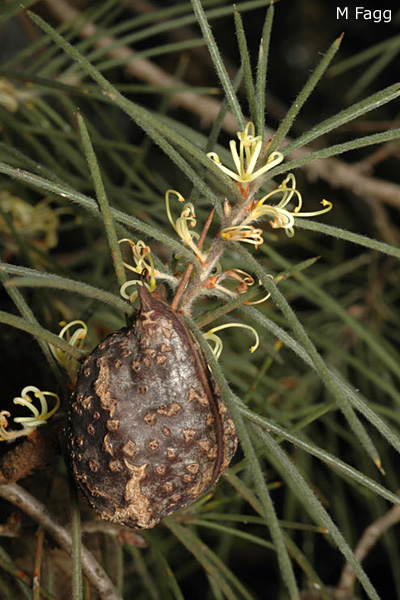General Description:
Hakea gibbosa is a small to medium sized shrub spreading to 1 to 3 metres high by the 1.5 metres in diameter. It has stiff grey-green, needle-like leaves up to 8cm long which are covered in fine hairs. In exposed situations it can have a particularly attractive dense habit. This is not a plant to plant near walkways as it is very prickly! The small, cream-coloured flowers occur in loose clusters in the leaf axils during early winter and are followed by ovoid, woody seed pods about 35mm long by 30mm wide. Despite their size, the pods only contain 2 winged seeds, the usual number for all Hakea species. The pods do not shed the seed until stimulated to do so by environmental conditions (e.g. after a bushfire).
Originally, Hakea gibbosa was thought to be more widespread in distribution, extending to south eastern Queensland and north eastern New South Wales. However, this northern form has now been recognized as a distinct species and given the name Hakea actites.
H.gibbosa was one of the first hakeas introduced and cultivated in England in the late 18th century, however, it is seldom grown these days. Its spiky habit and insignificant flowering compared with some other hakeas have probably contributed to its decline in popularity. Unfortunately the species has become a serious environmental weed in the Fynbos region of South Africa, where it was cultivated as a hedging plant. It has also become naturalized in New Zealand and on Norfolk Island.
In nature it grows on sandy well-drained soils and does best on similar ones in cultivation (although is fairly adaptable to other types of soils). It is best grown in an open, sunny position but it will tolerate a fair degree of shade. Hakea gibbosa is quick growing and reliable and makes a good screening plant.
Hakea gibbosa is easily grown from seed (preferably collected with thick gloves!) which generally germinates in around two weeks but may take longer. It can be grown from cuttings. Seed and plants are likely be found in nurseries specializing in indigenous flora near where it is found in nature, and given its weed potential, cultivation in other areas may not be advisable.

Hakea gibbosa
Photo: Murray Fagg – Australian National Botanic Gardens
 Australian Native Plants Society (Australia)
Australian Native Plants Society (Australia)